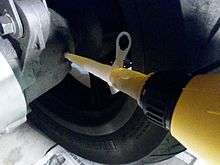Gear oil
Gear oil is a lubricant made specifically for transmissions, transfer cases, and differentials in automobiles, trucks, and other machinery. It is of a higher viscosity to better protect the gears and usually is associated with a strong sulfur smell. The high viscosity ensures transfer of lubricant throughout the gear train. This is necessary since the devices needing this heavy oil do not have pumps for transferring the oil with only a portion of the lowermost gears bathed in an oil sump. This heavy oil can create viscous drag leading to inefficiencies in vehicle operation. Some modern automatic transaxles (integrated transmission and differential) do not use a heavy oil at all but lubricate with the lower viscosity hydraulic fluid, which is available at pressure within the automatic transmission.
Most lubricants for manual gearboxes and differentials contain extreme pressure (EP) additives and antiwear additives to cope with the sliding action of hypoid bevel gears.

EP additives which contain phosphorus/sulfur compounds are corrosive to yellow metals such as the copper and/or brass used in bushings and synchronizers; the GL-1 class of gear oils does not contain any EP additives and thus finds use in applications which contain parts made of yellow metals.
GL-5 is not necessarily backward-compatible in synchro-mesh transmissions which are designed for a GL-4 oil: GL-5 has a lower coefficient of friction due to the higher concentration of EP additives over GL-4, and thus synchros can not engage as effectively. Also, transmissions which explicitly call for GL-4 oil may have been designed around this lower concentration of EP additives and thus may contain yellow metal parts which GL-5 will corrode. [1]
API ratings
Gear oils are classified by the American Petroleum Institute using GL ratings. For example, most modern gearboxes require a GL-4 oil, and separate differentials (where fitted) require a GL-5 oil. It is important that purchasers check the oil against the vehicle manufacturer's specification to ensure it does not contain any aggressive chemicals that may attack yellow metal gear components, such as phosphor bronze.
API viscosity ratings for gear oils are not directly comparable with those for motor oil, and they are thinner than the figures suggest. For example, many modern gearboxes use a 75W90 gear oil, which is actually of equivalent viscosity to a 10W40 motor oil. Multigrade gear oils are becoming more common; while gear oil does not reach the temperatures of motor oil, it does warm up appreciably as the car is driven, due mostly to shear friction (with a small amount of heat conduction through the bellhousing from the engine block).
Fully synthetic gear oils are also used in many vehicles, and have a greater resistance to shear breakdown than mineral oils.
API Category GL-1 (inactive*) designates the type of service characteristic of manual transmissions operating under such mild conditions of low unit pressures and minimum sliding velocities, that untreated oil may be used satisfactorily. Oxidation and rust inhibitors, defoamers and pour depressants may be used to improve the characteristics of lubricants intended for this service. Friction modifiers and extreme pressure additives shall not be used.
API Category GL-2 (inactive*) designates the type of service characteristic of automotive type worm-gear axles operating under such conditions of load, temperature and sliding velocities, that lubricants satisfactory for API GL-1 service will not suffice.
API Category GL-3 (inactive*) designates the type of service characteristic of manual transmissions and spiral-bevel axles operating under mild to moderate to severe conditions of speed and load. These service conditions require a lubricant having load-carrying capacities greater than those that will satisfy APL GL-1 service, but below the requirements of lubricants satisfying the API GL-4 service.
API Category GL-4 designates the type of service characteristic of spiral-bevel and hypoid gears in automotive axles operated under moderate speeds and loads. These oils may be used in selected manual transmission and transaxle applications.
API Category GL-5 designates the type of service characteristic of gears, particularly hypoids in automotive axles under high-speed and/or low-speed, high-torque conditions. Lubricants qualified under U.S. Military specification MIL-L-2105D (formerly MIL-L-2015C), MIL-PRF-2105E and SAE J2360 satisfy the requirements of the API GL-5 service designation.
API Category GL-6 (inactive*) designates the type of service characteristic of gears designed with a very high pinion offset. Such designs typically require (gear) score protection in excess of that provided by API GL-5 gear oils. The original API GL-6 test equipment is obsolete.
API Category MT-1 designates lubricants intended for non-synchronized manual transmissions used in buses and heavy-duty trucks. Lubricants meeting API MT-1 provide protection against the combination of thermal degradation, component wear, and oil seal deterioration which is not provided by lubricants meeting only the requirements of API GL-4 and API GL-5.
MIL-PRF-2105E this specification released in 1995 combines the performance requirements of its predecessor (MIL-L-2105D) and API MT-1. MIL-PRF-2105E maintains all existing chemical/physical requirements, stationary axle test requirements, field test requirements and data review by the Lubricants Review Institute that were required under MIL-L-2105D. It also adds the stringent oil seal compatibility and thermal durability test requirements under API MT-1. MIL-PRF-2105E has been re-written as SAE Standard J2360. SAE J2360 standard is a new global quality standard that defines a level of performance equivalent to that defined by MIL-PRF-2105E, a U.S. military standard for approval that was not available to oil blenders in all parts of the world. It includes all of the most recent axle and transmission testing requirements identified in API GL-5, API MT-1, and MIL-PRF-2105E including the need to demonstrate proof-of-performance through rigorous field testing.
- API Categories GL-1, GL-2, GL-3 and GL-6 were declared inactive by SAE Technical Committee 3 in 1995, even though oils may be marketed with these designations. Similarly, ASTM does not plan to maintain the performance tests associated with these categories, as in a number of cases these tests can no longer be run because parts or test installations are not available.